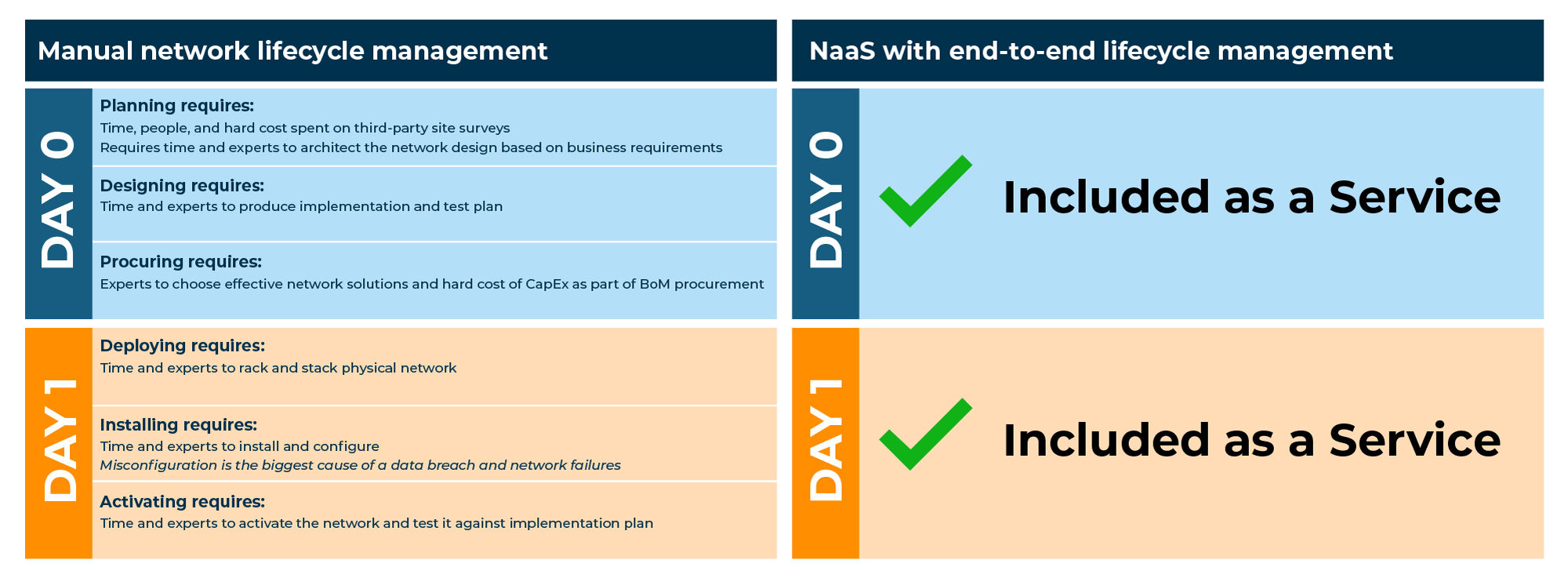Share Via
Deploying a network is complex, time-consuming, and expensive. That’s not new news. When referring to a network’s lifecycle, most people probably think of the network’s operations (i.e., the day-to-day operations/maintenance of the network often referred to as Day 2 within a network’s lifecycle). While the network’s operations are important, the initial design (i.e., Day 0) and installation (i.e., Day 1) are just as critical, if not more, as it sets the foundation for network performance. A scalable and easy-to-maintain network requires Day 0 and Day 1 to be properly implemented. However, often these steps are often done manually, require long and expensive billable hours, and require heavily trained experts to do effectively.
Network as a Service (NaaS) is a cloud-delivered model that offloads these burdens from an organization to a vendor by having the entire network’s lifecycle included as a Service (aaS). A purpose-built NaaS like the Nile Access Service engineers deep integration into the service architecture utilizing automated workflows and tools to ensure a network infrastructure that can be easily provisioned, automated, and managed with minimal human intervention.
What does Day 0 to Day N mean?
The network’s lifecycle is a model to describe the stages a network goes through. It can be classified into:
- Day 0: Initial planning and design of the network. This is where teams gather technical business requirements for successful implementation (e.g., network topology, required hardware, and software).
- Day 1: Installation, configuration, and activation of the network. Certified engineers will set up the network infrastructure, connect devices, and configure network settings to ensure network connectivity is up
- Day 2: Day-to-day operations and maintenance of the network. This stage is where IT teams monitor the network’s performance and security, troubleshoot any problems, and handle change management based on detected anomalies.
- Day N: The continuous evolution of the network. New features are introduced, hardware refreshes are installed, and software is upgraded to meet new business requirements.

Why is Day 0 and Day 1 important?
Day 0 and Day 1 of a network’s lifecycle are arguably two of the most critical phases in the life of a network. It is where the network goes from a blueprint and is brought to fruition. In order for businesses to adopt new technologies, provide reliable experiences, and scale quickly, it needs to be effectively done. The lack of careful implementation in each stage can result in unreliable and inefficient networks with complex configurations that require a large workforce to manage.

What makes Day 0 and Day 1 so complex?
As important as they are, managing the stages and transitioning from Day 0 to Day 1 is a complex and challenging process. There are a number of factors that can contribute to the success or failure of the transition, including:
Day 0 (Plan, design, and procure):
- Gathering all stakeholders to fully understand the involvement needed and the technical requirements necessary for the project to be successful
- Are all stakeholders involved and aligned on the project’s goals? If so, are all the requirements and information gathered? How are you securing the network to ensure compliance and a strong risk posture? What are the Service Level Agreements (SLAs) for the network, and how will they be enforced?
- Executing a high-definition customer site survey
- Are there wireless experts available to effectively survey locations?
- Creating a scalable and efficient network architecture
- Is the organization willing to sift through dozens of documents from vendors to see which features fit their requirements and implement them in a way that is optimized for their infrastructure?
- Delivering hardware and software seamlessly
- Are there processes in place to handle supply chain disruptions, long delays, and diminishing ROI?
Day 1 (Install, configure, and activate):
- Network installation
- Are the required resources (e.g., people, money, time) available to implement and manage the design?
- Network configuration
- Can the current team effectively implement and manage the design or does it need to be offloaded? Is the continuous configuration of the network make it easy to manage
- Network activation
- Can the team quickly activate the network as the organization scales or does it take highly certified experts to activate and test the network for anomalies?
If the answer is “No” to any of the above questions or not sure about what the answer is, it’s time to take a closer look at NaaS!
NaaS simplifies Day 0 and Day 1
Say Goodbye to Network Woes.
Network as a Service (NaaS) is a highly-automated network service delivery model that eliminates the complexities of managing a network’s lifecycle by taking care of it completely -aaS.
Doing Day 0 and Day 1 within a network’s lifecycle is often a complex and time-consuming process that while having an immense impact on the scalability and reliability of the network, is also prone to inefficient implementation. That is due to the fact that it does require specialized skills that many teams may not be familiar with.
NaaS by Nile eliminates the burden of manually managing Day 0 and Day 1.
Day 0: Highly Automated and Integrated Processes
- Expert-led site surveys to propose secure and high-performing networks without compromises
- Automation-driven network architecture to minimize IT involvement
- Enterprise-grade hardware and software to meet growing demands
Day 1: Simple Installation and Activation
- Zero network configurations are required to ensure there’s little chance of network failures from misconfigurations.
- Automation and simplicity that enable high scalability as organizations grow – The Nile Access Service is architected to get your network up and running fast. Nile installs the equipment, scans the QR code, and you get connected.
In summary, a good network experience should have a seamless Day 0 to Day 1 transition, be highly scalable, and have minimal interactions from the organization. The vendor should be completely transparent and completely responsible for a successful Day 0 and Day 1 implementation to ensure the challenges of future problems are minimized.
Share Via



